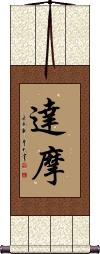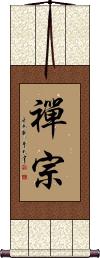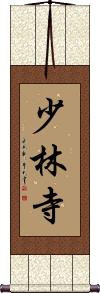Many custom options...
And formats...

Bodhidharma in Chinese / Japanese...
Buy a Bodhidharma calligraphy wall scroll here!
Personalize your custom “Bodhidharma” project by clicking the button next to your favorite “Bodhidharma” title below...
1. Bodhidharma
5. Zen Buddhism
Bodhidharma
菩提達磨 is the title Bodhidharma in Chinese and Japanese.
Bodhidharma, commonly known as Damo, is reputed as the founder of the Chan (Zen) or Intuitional or Mystic School.
He likely came from south India and spread Mahayana Buddhism throughout China (even meeting the Emperor) and his disciples likely spread this all the way to Korea, Japan, and beyond in the 5th and 6th centuries.
Sometimes the last character varies in Chinese to 摩 instead of 磨 - let me know if you need a certain variation when you order.
Bodhidharma
Dharma / Damo / Daruma
達摩 is the Chinese and Japanese title for Dharma (a short name for Bodhidharma).
He's known in Chinese as Damo and in Japanese as Daruma.
Note: In Japanese, they tend to write the last character as ![]() versus
versus ![]() . If you choose the Japanese master calligrapher, expect it to be written in the Japanese version.
. If you choose the Japanese master calligrapher, expect it to be written in the Japanese version.
Daruma / Damo
達磨 in Japanese usually refers to Daruma, a tumbling doll with a round red-painted body.
In Japan, Daruma is a good-luck doll which is supposed to in the shape of Bodhidharma, with a blank eye to be completed when a person's wish is granted.
達磨 is also Bodhidharma or Dharma. 達磨 comes from an ancient word that means holding fast and keeping ordinances, statutes, laws, or practice.
This is also a title for Damo, or Bodhidharma, the twenty-eighth Indian and first Chinese patriarch, who arrived in China A.D. 520, the reputed founder of the Chan or Intuitional School in China. He is described as son of a king in southern India. He famously engaged in silent meditation for nine years.
Facing the Wall Nine Years
面壁九年 is a Buddhist term that means “facing a wall for nine years.”
This refers to the Bodhidharma who stared at a wall in meditation at the Shaolin Temple (or in a cave) for nine years until reaching full enlightenment.
Zen Buddhism
禪宗 is one way to title “Zen Buddhism.” Because the original pronunciation of Zen in Chinese is Chan, you'll also see this expressed as Chan Buddhism.
From the Buddhist Dictionary:
The Chan, meditative or intuitional, sect is usually said to have been established in China by Bodhidharma, the twenty-eighth patriarch, who brought the tradition of the Buddha-mind from India. This sect, believing in direct enlightenment, disregarded ritual and sūtras and depended upon the inner light and personal influence for the propagation of its tenets, founding itself on the esoteric tradition supposed to have been imparted to Kāśyapa by the Buddha, who indicated his meaning by plucking a flower without further explanation. Kāśyapa smiled in apprehension and is supposed to have passed on this mystic method to the patriarchs. The successor of Bodhidharma was 慧可 Huike, and he was succeeded by 僧璨 Sengcan, 道信 Daoxin, 弘忍 Hongren, 慧能 Huineng, and 神秀 Shenxiu, the sect dividing under the two latter into the southern and northern schools: the southern school became prominent, producing 南嶽 Nanyue and 靑原 Qingyuan, the former succeeded by 馬祖 Mazu, the latter by 石頭 Shitou. From Mazu's school arose the five later schools.
Shaolin Temple
少林寺 is the full title of the Shaolin Temple.
This refers to the Buddhist monastery famous for its kung fu monks.
少林寺 is also known in Japanese, where they use the same characters but romanize them as Shourinji or Shōrinji.
Some believe this monastery and temple represent where Bodhidharma sat with his face to a wall for nine years, leading to his discovery of enlightenment and the establishment of Buddhism in China.
Not the results for bodhidharma that you were looking for?
Below are some entries from our dictionary that may match your bodhidharma search...
| Characters If shown, 2nd row is Simp. Chinese |
Pronunciation Romanization |
Simple Dictionary Definition |
坐禪 坐禅 see styles |
zuò chán zuo4 chan2 tso ch`an tso chan zazen |
More info & calligraphy: Sit in MeditationTo sit in dhyāna, i.e. abstract meditation, fixed abstraction, contemplation; its introduction to China is attributed to Bodhidharma (though it came earlier), and its extension to Tiantai. |
禪宗 禅宗 see styles |
chán zōng chan2 zong1 ch`an tsung chan tsung Zenshū |
More info & calligraphy: Zen BuddhismThe Chan, meditative or intuitional, sect usually said to have been established in China by Bodhidharma, v. 達, the twenty-eighth patriarch, who brought the tradition of the Buddha-mind from India. Cf. 楞 13 Laṅkāvatāra sūtra. This sect, believing in direct enlightenment, disregarded ritual and sūtras and depended upon the inner light and personal influence for the propagation of its tenets, founding itself on the esoteric tradition supposed to have been imparted to Kāśyapa by the Buddha, who indicated his meaning by plucking a flower without further explanation. Kāśyapa smiled in apprehension and is supposed to have passed on this mystic method to the patriarchs. The successor of Bodhidharma was 慧可 Huike, and he was succeeded by 僧璨 Sengcan; 道信 Daoxin; 弘忍 Hongren; 慧能 Huineng, and 神秀 Shenxiu, the sect dividing under the two latter into the southern and northern schools: the southern school became prominent, producing 南嶽 Nanyue and 靑原 Qingyuan, the former succeeded by 馬祖 Mazu, the latter by 石頭 Shitou. From Mazu's school arose the five later schools, v. 禪門. |
達磨 达磨 see styles |
dá mó da2 mo2 ta mo daruma だるま |
More info & calligraphy: Daruma / Damodharma; also 達摩; 達麼; 達而麻耶; 曇摩; 馱摩 tr. by 法. dharma is from dhara, holding, bearing, possessing, etc.; and means 'that which is to be held fast or kept, ordinance, statute, law, usage, practice'; 'anything right.' M.W. It may be variously intp. as (1) characteristic, attribute, predicate; (2) the bearer, the transcendent substratum of single elements of conscious life; (3) element, i.e. a part of conscious life; (4) nirvāṇa, i.e. the Dharma par excellence, the object of Buddhist teaching; (5) the absolute, the real; (6) the teaching or religion of Buddha; (7) thing, object, appearance. Also, Damo, or Bodhidharma, the twenty-eighth Indian and first Chinese patriarch, who arrived in China A.D. 520, the reputed founder of the Chan or Intuitional School in China. He is described as son of a king in southern India; originally called Bodhitara. He arrived at Guangdong, bringing it is said the sacred begging-bowl, and settled in Luoyang, where he engaged in silent meditation for nine years, whence he received the title of wall-gazing Brahman 壁觀婆羅門, though he was a kṣatriya. His doctrine and practice were those of the 'inner light', independent of the written word, but to 慧可 Huike, his successor, he commended the Laṅkāvatāra-sūtra as nearest to his views. There are many names with Dharma as initial: Dharmapāla, Dharmagupta, Dharmayaśas, Dharmaruci, Dharmarakṣa, Dharmatrāta, Dharmavardhana, etc. |
少林寺 see styles |
shào lín sì shao4 lin2 si4 shao lin ssu shourinji / shorinji しょうりんじ |
More info & calligraphy: Shaolin Temple(place-name) Shaolin Temple (China); Shourinji The monastery at 少室 in 登封 Dengfeng xian, Henanfu, where Bodhidharma sat with his face to a wall for nine years. |
菩提達磨 菩提达磨 see styles |
pú tí dá mó pu2 ti2 da2 mo2 p`u t`i ta mo pu ti ta mo bodaidaruma ぼだいだるま |
More info & calligraphy: BodhidharmaBodhidharma, commonly known as Damo, v. 達; reputed as the founder of the Chan (Zen) or Intuitional or Mystic School. His original name is given as 菩提多羅 Bodhitara. |
面壁九年 see styles |
miàn bì jiǔ nián mian4 bi4 jiu3 nian2 mien pi chiu nien menpekikunen めんぺきくねん |
More info & calligraphy: Facing the Wall Nine Yearsnine years facing the wall |
七祖 see styles |
qī zǔ qi1 zu3 ch`i tsu chi tsu shichiso |
(1) The seven founders of the 華嚴 Huayan School, whose names are given as 馬鳴 Aśvaghoṣa, 龍樹 Nāgārjuna 杜順 (i.e. 法順) , Zhiyan 智儼, Fazang 法藏, Chengguan 澄觀 and Zongmi 宗密; (2) the seven founders of the 禪Chan School, i.e. 達磨 or 菩提達磨 Bodhidharma, Huike 慧可, Sengcan 僧璨, Daoxin 道信, Hongren 弘忍, Huineng 慧能 and Heze 荷澤 (or Shenhui 神曾); (3) The seven founders of the 淨土 Pure Land School, i.e. Nagarjuna, 世親 Vasubandhu, Tanluan 曇鸞, Daochuo 道綽, Shandao 善導, Yuanxin 源信 and Yuankong 源空 (or Faran 法然), whose teaching is contained in the Qizushengjiao 七祖聖教. |
六祖 see styles |
liù zǔ liu4 zu3 liu tsu rokuso |
The six patriarchs of the Ch'an (Zen) school 禪宗, who passed down robe and begging bowl in succession i. e. Bodhidharma, Huike, Sengcan, Daoxin, Hongren, and Huineng 達摩, 慧可, 僧璨, 道信, 弘忍, and 慧能. |
北宗 see styles |
běi zōng bei3 zong1 pei tsung kitamune きたむね |
(surname) Kitamune The northern school of the Chan (Zen) sect; from Bodhidharma 達磨 to the fifth patriarch 弘忍 Hongren the school was undivided; from 慧能 Huineng began the division of the southern school, 神秀 Shenxiu maintaining the northern; it was the southern school which prevailed. |
南宗 see styles |
nán zōng nan2 zong1 nan tsung nanshū |
The Southern sect, or Bodhidharma School, divided into northern and southern, the northern under 神秀 Shen-hsiu, the southern under 慧能 Hui-nang, circa A.D. 700, hence 南能北秀; the southern came to be considered the orthodox Intuitional school. The phrase 南頓北漸 or 'Southern immediate, northern gradual' refers to the method of enlightenment which separated the two schools. |
壁觀 壁观 see styles |
bì guān bi4 guan1 pi kuan hekkan |
The wall-gazer, applied to Bodhidharma, who is said to have gazed at a wall for nine years. Also a name for the meditation of the Chan school. |
少室 see styles |
shǎo shì shao3 shi4 shao shih Shōshitsu |
Shaoshi, a hill on the 嵩山 Sungshan where Bodhidharma set up his 少林寺 infra. |
慧可 see styles |
huì kě hui4 ke3 hui k`o hui ko eka えか |
(person) Huike (487-593 CE) Huike, the successor of Bodhidharma, v. 達; he previously cut off his arm in appeal to be received as disciple, and finally inherited his mantle and alms-bowl. |
折蘆 折芦 see styles |
zhé lú zhe2 lu2 che lu setsuro せつろ |
(given name) Setsuro The snapped-off reed on which Bodhidharma is said to have crossed the Yangtsze from Nanking. |
祖師 祖师 see styles |
zǔ shī zu3 shi1 tsu shih soshi そし |
founder (of a craft, religious sect etc) founder of a sect; (surname) Soshi A first teacher, or leader, founder of a school or sect; it has particular reference to Bodhidharma. |
禪法 禅法 see styles |
chán fǎ chan2 fa3 ch`an fa chan fa zenpō |
Methods of mysticism as found in (1) the dhyānas recorded in the sūtras, called 如來禪 tathāgata-dhyānas; (2) traditional dhyāna, or the intuitional method brought to China by Bodhidharma, called 祖師禪, which also includes dhyāna ideas represented by some external act having an occult indication. |
禪門 禅门 see styles |
chán mén chan2 men2 ch`an men chan men zenmon |
The meditative method in general. The dhyāna pāramitā, v. 六度. The intuitional school established in China according to tradition by Bodhidharma, personally propagated from mind to mind as an esoteric school. |
胡子 see styles |
hú zǐ hu2 zi3 hu tzu koko ここ |
(female given name) Koko Hun, or Turk, a term applied to the people west and north of China; a nickname for Bodhidharma. |
達摩 达摩 see styles |
dá mó da2 mo2 ta mo daruma だるま |
Dharma, the teaching of Buddha; Bodhidharma (surname) Daruma (Skt. dharma) |
金鷄 金鸡 see styles |
jīn jī jin1 ji1 chin chi kinkei |
The golden cock (or, fowl), with a grain of millet in its beak, a name for Bodhidharma. |
鉢多 钵多 see styles |
bō duō bo1 duo1 po to hatta |
(鉢多羅) pātra, a bowl, vessel, receptacle, an almsbowl; also 鉢呾羅; 鉢和羅 (or 鉢和蘭); 波怛囉 (or 播怛囉); in brief 鉢. The almsbowl of the Buddha is said to have been brought by Bodhidharma to China in A. D. 520. |
面壁 see styles |
miàn bì mian4 bi4 mien pi omokabe おもかべ |
to face the wall; to sit facing the wall in meditation (Buddhism); (fig.) to devote oneself to study, work etc (n,vs,vi) meditation facing a wall; (surname) Omokabe To sit in meditation with the face to a wall, as did Bodhidharma for nine years, without uttering a word. |
佛心宗 see styles |
fó xīn zōng fo2 xin1 zong1 fo hsin tsung Busshin Shū |
The sect of the Buddha-heart, i.e. the Chan (Zen) or Intuitive sect of Bodhidharma, holding that each individual has direct access to Buddha through meditation. |
天台宗 see styles |
tiān tái zōng tian1 tai2 zong1 t`ien t`ai tsung tien tai tsung tendaishuu / tendaishu てんだいしゅう |
Tiantai school of Buddhism Tendai sect (of Buddhism); (personal name) Tendaishuu The Tiantai, or Tendai, sect founded by 智顗 Zhiyi. It bases its tenets on the Lotus Sutra 法華經 with the 智度論, 涅盤經, and 大品經; it maintains the identity of the Absolute and the world of phenomena, and attempts to unlock the secrets of all phenomena by means of meditation. It flourished during the Tang dynasty. Under the Sung, when the school was decadent, arose 四明 Ciming, under whom there came the division of 山家 Hill or Tiantai School and 山外 the School outside, the latter following 悟恩 Wuen and in time dying out; the former, a more profound school, adhered to Ciming; it was from this school that the Tiantai doctrine spread to Japan. The three principal works of the Tiantai founder are called 天台三部, i. e. 玄義 exposition of the deeper meaning of the Lotus; 文句 exposition of its text; and 止觀 meditation; the last was directive and practical; it was in the line of Bodhidharma, stressing the 'inner light'. |
楞伽經 楞伽经 see styles |
lèng qié jīng leng4 qie2 jing1 leng ch`ieh ching leng chieh ching Ryōga kyō |
The Laṅkāvatāra sūtra, a philosophical discourse attributed to Śākyamuni as delivered on the Laṅka mountain in Ceylon. It may have been composed in the fourth or fifth century A.D.; it "represents a mature phase of speculation and not only criticizes the Sāṅkhya, Pāśupata and other Hindu schools, but is conscious of the growing resemblance of Mahāyānism to Brahmanic philosophy and tries to explain it". Eliot. There have been four translations into Chinese, the first by Dharmarakṣa between 412-433, which no longer exists; the second was by Guṇabhadra in 443, ca11ed 楞伽 阿跋多羅寶經 4 juan; the third by Bodhiruci in 513, called 入楞伽經 10 juan; the fourth by Śikṣānanda in 700-704, called 大乘入楞伽經 7 juan. There are many treatises and commentaries on it, by Faxian and others. See Studies in the Laṅkāvatāra Sūtra by Suzuki and his translation of it. This was the sūtra allowed by Bodhidharma, and is the recognized text of the Chan (Zen) School. There are numerous treatises on it. |
熊耳山 see styles |
xióng ěr shān xiong2 er3 shan1 hsiung erh shan Yūji san |
Mt Xiong'er national geological park in 棗莊|枣庄[Zao3 zhuang1], south Shandong Bear's ear mount, the place, where Bodhidharma was buried. |
碧眼胡 see styles |
bì yǎn hú bi4 yan3 hu2 pi yen hu Hekigenko |
The blue-eyed barbarian, Bodhidharma. |
祖師禅 see styles |
soshizen そしぜん |
(See 如来禅) Zen Buddhism based on the teachings of Bodhidharma |
穿耳僧 see styles |
chuān ěr sēng chuan1 er3 seng1 ch`uan erh seng chuan erh seng senni sō |
Pierced-ear monks, many of the Indian monks wore ear-rings; Bodhidharma was called 穿耳客 the ear-pierced guest. |
達磨宗 达磨宗 see styles |
dá mó zōng da2 mo2 zong1 ta mo tsung darumashuu / darumashu だるましゅう |
(1) (rare) (See 禅宗) Zen (Buddhism); (2) (derogatory term) (archaism) (See 達磨歌) confusing style of middle-age Japanese poetry The Damo, or Dharma sect, i.e. the 禪宗 Meditation, or Intuitional School. |
Click here for more bodhidharma results from our dictionary
The following table may be helpful for those studying Chinese or Japanese...
| Title | Characters | Romaji (Romanized Japanese) | Various forms of Romanized Chinese | |
| Bodhidharma | 菩提達磨 菩提达磨 | bodai daruma bodaidaruma | pú tí dá mó pu2 ti2 da2 mo2 pu ti da mo putidamo | p`u t`i ta mo putitamo pu ti ta mo |
| Bodhidharma | 菩提達摩 / 菩提達磨 菩提达摩 / 菩提达磨 | bo dai daru ma bodaidaruma | pú tí dá mó pu2 ti2 da2 mo2 pu ti da mo putidamo | p`u t`i ta mo putitamo pu ti ta mo |
| Dharma Damo Daruma | 達摩 / 達磨 达摩 / 达磨 | daru ma / daruma | dá mó / da2 mo2 / da mo / damo | ta mo / tamo |
| Daruma Damo | 達磨 达磨 | daruma | dá mó / da2 mo2 / da mo / damo | ta mo / tamo |
| Facing the Wall Nine Years | 面壁九年 | menpeki kyunen menpekikyunen | miàn bì jiǔ nián mian4 bi4 jiu3 nian2 mian bi jiu nian mianbijiunian | mien pi chiu nien mienpichiunien |
| Zen Buddhism | 禪宗 禅宗 | zen shuu / zenshuu / zen shu | chán zōng chan2 zong1 chan zong chanzong | ch`an tsung chantsung chan tsung |
| Shaolin Temple | 少林寺 | shou rin ji shourinji sho rin ji | shào lín sì shao4 lin2 si4 shao lin si shaolinsi | shao lin ssu shaolinssu |
| In some entries above you will see that characters have different versions above and below a line. In these cases, the characters above the line are Traditional Chinese, while the ones below are Simplified Chinese. | ||||
Successful Chinese Character and Japanese Kanji calligraphy searches within the last few hours...










